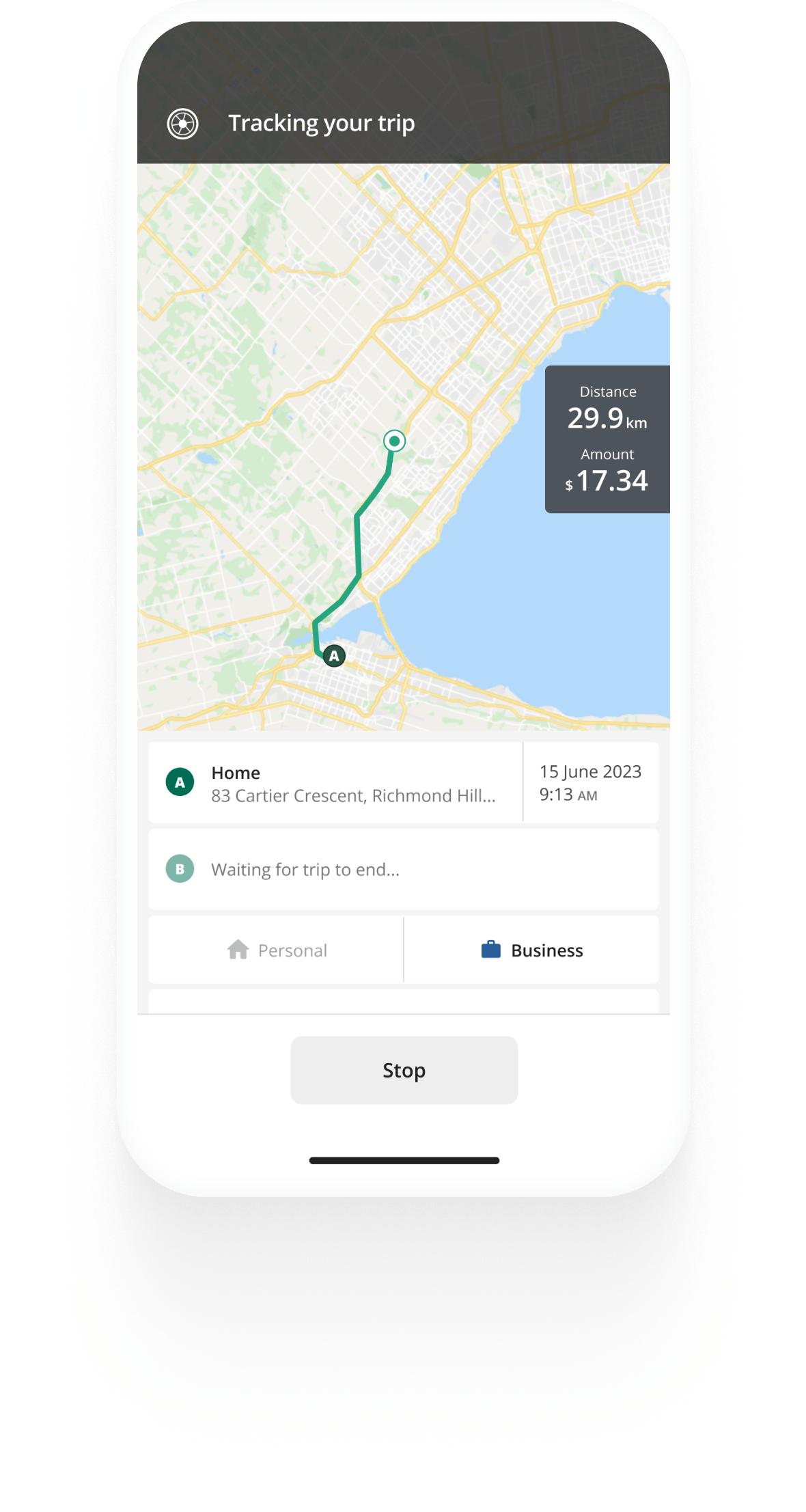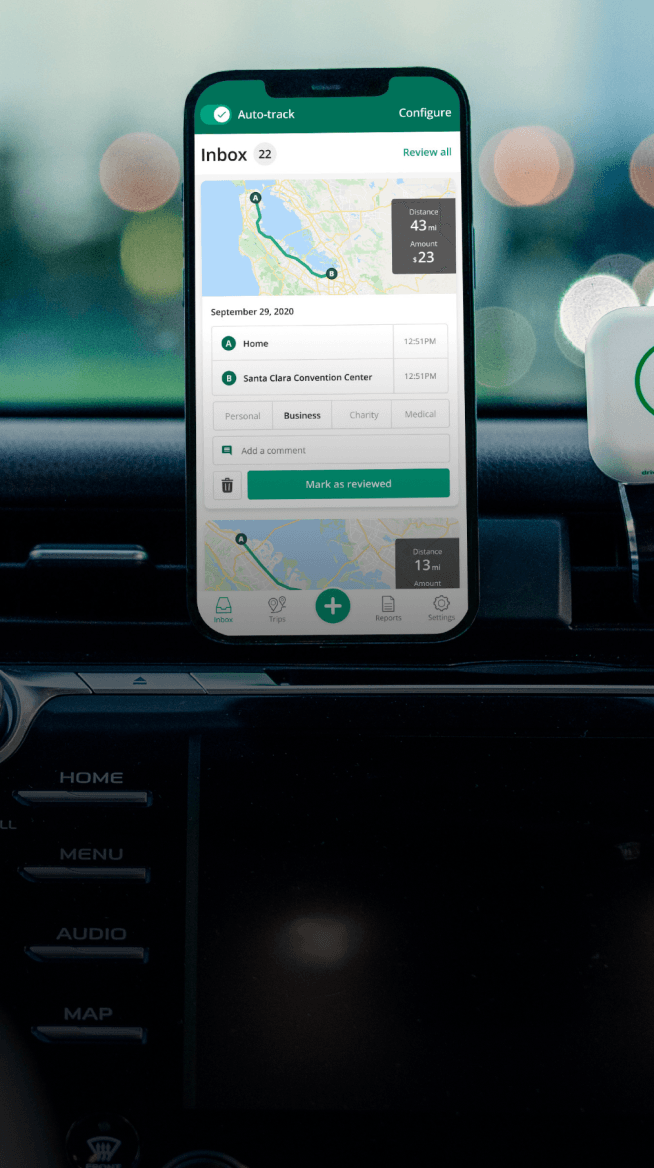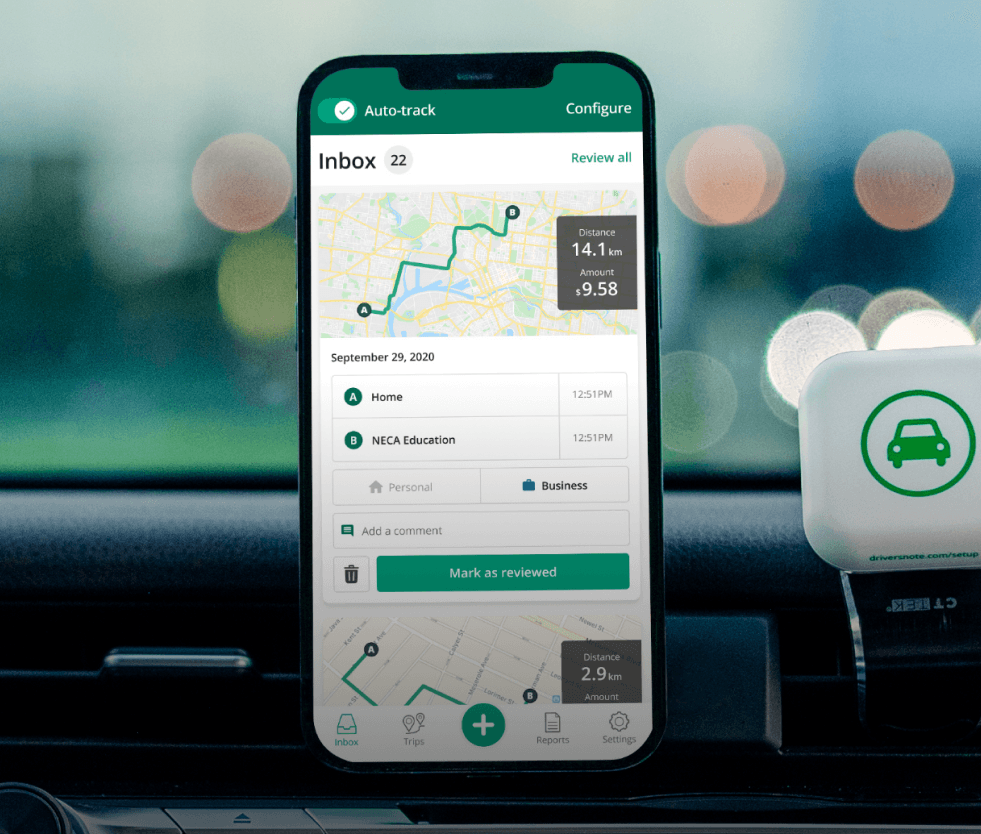Track mileage automatically
Get started
Company Cars: What Employers Need to Know About the Automobile Taxable Benefit
For many employees, access to a company car is a nice perk, and if they’re allowed to use it for private trips and errands, that's (probably) even better.
As an employer, the benefits of providing company cars include that you decide on the make and models, you can use vehicles for branding, and you can provide benefits to help you attract talent.
But hit the brakes for a minute. Company cars come with obligations, especially if employees can use them privately.
This blog will highlight the employer’s role and responsibility regarding company cars. If you’re an employee, head to this blog: Personal Use of Company Cars - Is It a Taxable Benefit?
Tax implications of company cars used for business and private
The tax rules around company cars can get tricky, so let us help you help your team.
We start with the big picture:
- When you provide an employee with a company car they can use personally, it’s a taxable benefit for the employee.
- It’s up to you, the employer, to calculate the value of that benefit and report it on the employee’s T4 slip, which means that for you, it will require more payroll admin.
- Your employee is responsible for keeping accurate, detailed logs of how the car is used and for providing you with that information.
You decide the reporting frequency and how you’d like to receive the logs. Pro tip: Using a digital mileage tracking solution will save everyone time and effort.
Avoid the administrative burden of an audit. If the CRA challenges the distance reports, the employee will be held accountable for verifying all information since it is relevant to their income tax. However, the company might also face administrative burdens and scrutiny during an audit.
Now, let’s dive into the details.


Track business driving with ease
Trusted by millions of drivers
Automate your logbook Automate your logbook

Automatic mileage tracking and CRA-compliant reporting.
Get started for free Get started for freeHow to calculate the automobile taxable benefit
You calculate the automobile taxable benefit from two different components:
1. Operating cost benefit: This is the benefit the employee experiences when the company pays the operational costs. These expenses include fuel, maintenance, repair, insurance, etc.
Note: The CRA provides a rate per kilometre to cover operational expenses. The taxable benefit rate for 2025 is 34 cents per kilometre of personal use of a company car, or 31 cents per kilometre if you are employed in selling or leasing automobiles.
2. Standby charge benefit: The standby charge benefit is a taxable benefit that an employee receives when a company vehicle is made available to them for personal use, even if the vehicle isn't actually used. Essentially, it's the benefit of having access to a company-provided car for personal purposes.
The value of the benefit depends on the purchase price and the number of days the car is available for the employee’s personal use.
The standard standby charge calculation is 2% of the original cost of the automobile, or 2/3 of the lease costs, per month for every 30 days in a year in which the vehicle is available to the employee. The total days available are divided by 30 to calculate the number of 30-day periods.
Standby charge example
To illustrate, let’s say you give John a company car he can use privately. The car costs $25,000, and it’s available for him to use privately all year round.
- Cost of the car: $25,000
- Standard calculation for standby charge: 2% or 0.02
- Availability of 365 days, broken down into weeks: 12 (because there are 12 30-day periods in 365 days).
In this example, the standby charge benefit equals $25,000 x .02 x 12 = $6,000.00.
|
Which amount do you include on the employee’s T4 payslip? Operational cost + standby charge - reimbursement |
Variables that affect the taxable amount
But other factors come into play: If your employee reimburses you any operational costs or standby charges, you need to subtract these from the total, and if the car is used more than 50% for business, the employee is eligible for a reduced standby charge.
Reduced standby charge
A reduced standby charge applies when:
- The company car is used for business more than 50% of the available time, and
- Personal driving does not exceed 1,667 kilometres per month (or 20,004 kilometres per year)
How do you calculate the reduction?
When an employee qualifies for a reduced standby charge, you apply the Benefit Reduction Ratio (BRR) as in the following example.
|
BRR (Benefit Reduction Ratio) = Personal kilometres driven ÷ (1,667 × number of 30-day periods the vehicle was available to the employee). |
Example: John's reduced standby charge
Let's say John drove 25,000 kilometres in total, of which 6,000 was personal.
Step 1: Calculate the regular standby charge
- Car cost: $25,000
- Standard rate: 2% (0.02)
- Availability: 365 days (12 thirty-day periods)
- Regular standby charge: $25,000 × 0.02 × 12 = $6,000
Step 2: Calculate the Benefit Reduction Ratio (BRR)
- Personal kilometres: 6,000
- Formula: 6,000 ÷ (12 × 1,667)
- BRR = 6,000 ÷ 20,004 = 0.2999
Step 3: Apply the BRR to get the reduced standby charge
- Reduced standby charge: $25,000 × 0.02 × 12 × 0.2999 = $1,799.40
This significantly lowers the taxable benefit (from $6,000 to $1,799.40).
Automobile Benefit Online Calculator (aboc)
You can also use the CRA’s calculator to estimate the automobile taxable benefit amount. If your employee is not eligible for the reduced standby charge, you can calculate the benefit using the simplified method. Please visit the CRA website to learn more.
Employee logbook requirements
How can you tell how much your employees drive their company vehicles—and more importantly, whether more than 50% of that use is for business purposes? To assess this accurately, each employee should maintain and submit a detailed and accurate logbook.
This documentation is crucial for determining the standby charge benefit and, when eligible, for applying a reduced standby charge.
According to the CRA:
“The best evidence to support the use of a vehicle is an accurate logbook of business travel maintained for the entire year, showing for each business trip, the destination, the reason for the trip and the distance covered.”
Simplifying compliance with technology
Consider providing employees with clear and simple guidelines for business mileage tracking to make this easier for everyone, especially given how complex tax compliance can be.
Guidelines for company car mileage tracking
1. What to include in every logbook entry:
- Date of the trip
- Starting point and destination
- Purpose of the trip (e.g. client meeting, delivery, site visit)
- Odometer reading at the start and end of the trip
- Distance driven (in kilometres)
- Note if any personal use occurred on the same day
2. Which format to use and when to submit it:
Suggest a preferred format (paper logbook, Excel sheet, or a CRA-compliant mobile app, like Driversnote). Make it clear that employees should submit their logbooks regularly. Monthly submissions are ideal, as they help ensure records are accurate, complete, and up to date throughout the year.
4. Annual Logbook Review:
- Schedule a yearly review in December or early January to finalise year-end numbers for T4 reporting.
- Compare total kilometres driven vs. business kilometres for CRA reporting accuracy.
Vehicle change
The CRA requires recording the odometer reading at the start and end of the fiscal period. If a vehicle changes during the fiscal period, the dates and the odometer readings when buying, selling, or trading the vehicle should also be recorded.
How long should you keep logbook records?
The CRA requires businesses to retain vehicle logbook records for at least six years from the end of the last tax year to which they relate. After completing a full year of detailed tracking, you may choose to have your employees switch to the simplified logbook method, provided it meets CRA criteria.
Also read: CRA Mileage Log Requirements and the Simplified Method.
Simplify company mileage tracking for your team with Driversnote
You can simplify your team's mileage workload and simplify reporting, mileage submission and approval using our Driversnote for Teams solution.
It complies with CRA requirements and makes it easy for employees to log and send necessary reports. At the same time, you ensure that the documentation you get is sufficient and consistent, and details all business trips. The app can be combined with an iBeacon, which automates tracking and makes it easy to classify trips as business or personal.
Employer benefits
- Standardised tracking and reporting for all drivers
- CRA-compliant reports and documentation
- Easy approval of mileage claims
- Prevent over-reporting of business mileage
Benefits for your employees
- Automatically track all trips with minimal effort
- Quickly classify trips as business or personal
- Avoid maintaining manual logbooks
Is a company car worth the hassle?
Providing a company car does increase administrative work for your business and results in a taxable benefit for the employee. However, it also offers advantages, such as promoting your brand and helping you attract and retain top talent.
In the end, it comes down to your priorities and resources. Suppose you wish to offer employees a simpler, tax-free alternative. In that case, you might consider providing a car allowance as a fixed monthly payment or based on CRA-approved per-kilometre reimbursement rates.
(Rotate your phone for a better view of the table).
| Company car | Car allowance | |
|---|---|---|
|
Definition |
Employer provides a vehicle for employee’s business (and personal) use. |
Employer pays employee to use their personal vehicle for business use. |
|
Vehicle Ownership |
Employer-owned or leased. |
Employee-owned. |
| Cost to Employer | Capital or lease costs + ongoing operating expenses. | Monthly cost (allowance or per-km rate). |
| Tax Reporting Complexity |
High – must calculate and report taxable benefits on T4. |
Low – flat allowance included in income. Per-km reimbursements are excluded. |
| Taxable to Employee? |
Yes – includes standby charge and operating cost benefit. |
It depends.
|
| Mileage Logging Required? |
Yes, required for:
|
Yes, if using per-km reimbursement (CRA-compliant logs of business use). |
Also read: Company Cars vs Car Allowance: Which Is Best For Your Company?
FAQ

Tired of logging mileage by hand?
Effortless. CRA-compliant. Liberating.
Top posts
- Mileage Calculator Canada
- Self-Employed Tax Deductions you Should Claim in Canada
- Free CRA Mileage Log Template
Related posts
CRA Mileage Rate 2024
Latest update: February 20, 2024 - 2 min read
The CRA announces 2024 rates for vehicle allowance: From January 1st, 2024, per kilometre rates will increase 2 cents over 2023.
Mileage Calculator Canada
Latest update: October 27, 2025 - 2 min read
Choose a CRA per-kilometre rate or enter your own. Simply enter how many km you drove to calculate your allowance or deduction.
Self-Employed Tax Deductions you Should Claim in Canada
Latest update: October 22, 2025 - 2 min read
See a list of common tax deductions for self-employed individuals in Canada and how to claim them at tax time to maximize your tax savings.


.svg)